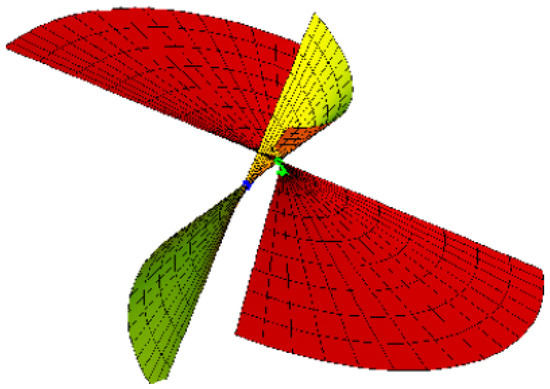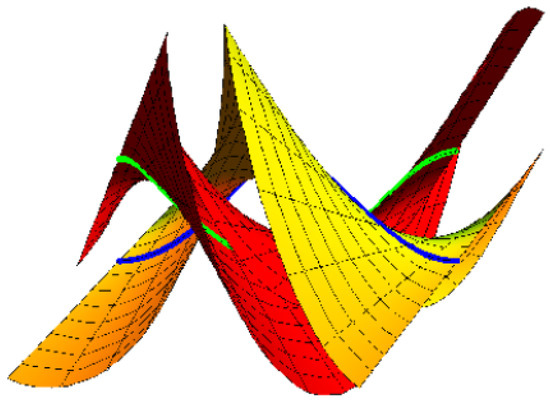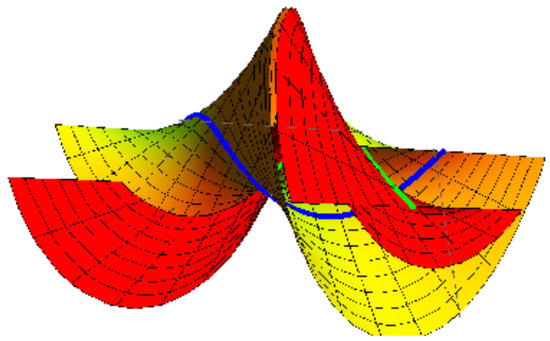Abstract
In this paper, we obtain the necessary and sufficient conditions of a surface pencil pair interpolating a Bertrand pair as common asymptotic curves in Euclidean 3-space . Afterwards, the conclusion to the ruled surface pencil pair is also obtained. Meanwhile, the epitomes are stated to emphasize that the proposed methods are effective in product manufacturing by adjusting the shapes of the surface pencil pair.
MSC:
53A04; 53A05; 53A17
1. Introduction
An asymptotic curve on a surface is an essential geometrical characteristic that plays a major role in a variety of implementations, such as the design of hulls, car shells, knife rests, cloths, etc. In the context of geometry, an asymptotic curve is a curve constantly tangent to an asymptotic trend (direction) of the surface. It is occasionally named an asymptotic line, although it is not required to be a line. An asymptotic trend is one for which the normal curvature is identically zero. This means that, for a point on an asymptotic curve, we take the plane that affords both the surface’s normal and the curve’s tangent at this point. The intersection curve of the plane and the surface will have zero curvature at this point. Asymptotic trends can only arise if the Gaussian curvature is negative (or zero). There will be two asymptotic trends if every point has a negative Gaussian curvature; these trends are halved by the principal lines [1,2]. In practical applications, essential work has focused on the reverse problem or backward analysis: given a 3D curve, how can we define those surfaces that possess this curve as a special curve, rather than finding and assorting curves on analytical curved surfaces? Wang et al. [3] considered the issue of constructing a surface pencil from a specified spatial geodesic curve, through which each surface can be a candidate for style design. They proved the necessary and sufficient conditions for the coefficients to be content with both the geodesic and the isoparametric requirements. This scheme has been utilized by numerous researchers (see, for example, [4,5,6,7,8,9,10,11,12,13,14,15,16]).
In the context of the theory of special curves, the consistency relationship among the curves is a fascinating issue. The Bertrand curve is one of the best-known special curves. Two curves are called a Bertrand pair if there exists a consistency relationship among their principal normals at the analogical points [1,2]. The Bertrand curve can be evaluated as the popularization of the helix. The helix, as a certain type of curve, has attracted the attention of mathematicians as well as scientists because of its diverse implementations; for instance, the Bertrand curves represent special models of offset curves, which are used in computer-aided manufacturing (CAM) and computer-aided design (CAD) (see [17,18,19]). However, to our knowledge, there is no work that designs a surface pencil pair interpolating a Bertrand pair to be asymptotic curves in Euclidean 3-space . This paper is intended to satisfy such a requirement; we evaluate a Bertrand pair as asymptotic curves to model a surface pencil pair in . Moreover, a ruled surface is indispensable for various areas of CAGD; regarding the aim of this work, the conclusion to the ruled surface pencil pair is also outlined. Meanwhile, some examples are shown to depict the surface pencil and ruled surface pencil with common Bertrand asymptotic curves.
2. Preliminaries
In this section, we list the most important notations that we use in this paper [1,2]. A curve is regular if it possesses a tangent line at each point of the curve. In the following, all curves are supposed to be regular. Given a spatial curve , it is expressed by arc length parameter s. We assume 0 for all s∈, since this would give a straight line. In this paper, and indicate the derivatives of with respect to arc length parameter s and arbitrary parameter v, respectively. For each point of , the set , , is named the Serret–Frenet frame on , where , and are the unit tangent, principal normal, and binormal vectors of the curve at the point , respectively. The arc length derivative of the Serret–Frenet frame is [1,2]
where the curvature and torsion are specified by
In spite of the fact that the arc length parameter is simple to analyze, in the majority of feasible situations, the parameter of a specified curve is commonly not in arc length parametrization. We can symbolize the specified curve by employing arc length parametrization. Given the curve
where the parameter v is not the arc length. The synthesis of the Serret–Frenet frame is specified by [1,2]
and the Serret–Frenet formula is
We utilize basic notation for the Bertrand pair from [1,2]: Let and be two curves in ; and are the principal normal vectors of them, respectively; the pair {, } is named a Bertrand pair if and are linearly dependent at the congruent points. is named the Bertrand mate of , and
where f is steady. Therefore, the associations of the Serret–Frenet frame of with that of are
where is a constant angle.
We represent a surface M by
If , the surface normal is
which is perpendicular to the vectors and .
Definition 1
([1,2]). A curve on a surface is asymptotic if and only if the binormal vector of the curve is everywhere parallel to the surface normal.
A curve on a surface is an isoparametric curve if it has a stationary s or t-parameter value. In other words, there exists a parameter such that or . Given a parametric curve , we call it an isoasymptotic curve of the surface if it is both an asymptotic and a parameter curve on .
3. Main Results
This section presents a new approach to constructing a surface pencil pair interpolating a Bertrand pair as common asymptotic curves in . To do this, we take into consideration a Bertrand pair, such that the surfaces’ tangent planes are concomitant with the curves’ osculating planes.
Let be a curve with ; is the Bertrand mate of , and , , , is the Frenet–Serret apparatus of as in Equation (1). The surface pencil M interpolating can be denoted by
Similarly, the surface pencil interpolating is denoted by
Here, , are named marching-scale functions, and .
In order to obtain the interpolating as a mutual asymptotic curve, according to Equations (8) and (9), we examine what the marching-scale functions should fulfill. To do this, we have
and
Since is isoparametric on , there exists a value such that ; in other words,
Thus, as , i.e., over , we have
The coincidence of the binormal with surface normal identifies as an asymptotic curve. We utilize {M, } to indicate the surface pencil pair. Then, from Equations (9)–(13), we derive the following theorem.
Theorem 1.
{M, } interpolate the Bertrand pair {, } as common asymptotic curves if and only if
We call M and , expressed by by Equations (8) and (9) and satisfying the conditions (14), an asymptotic surface pencil pair interpolating a Bertrand pair, since the common asymptotic curves are also a Bertrand pair. Any {M, } satisfying the conditions of Equation (14) is a member of this surface pencil pair. As reported in [3], for ease of interpretation, the marching-scale functions and can be displayed as two factors:
, and are functions that do not identically vanish. Then, we can obtain the below corollary.
Corollary 1.
{M, } interpolate the Bertrand pair {, } as common asymptotic curves if and only if
To confirm that {M, } interpolate the Bertrand pair {, }, we can first design the marching-scale functions in Equation (16), and then use them in Equations (8) and (9) to specify the parameterization. For suitability in practice, the functions and can be moreover constrained to be in extra limited forms and still possess sufficient degrees of freedom to specify a large pencil pair interpolating the Bertrand pair {, } as common asymptotic curves. Therefore, let us assume that and can be displayed as follows.
(1) If
then,
where , , , , and , and are not identically zero.
(2) If
then
where , , , , and , and are not identically zero.
Since the parameters , control the shape of {M, }, we can adjust these parameters to output {M, }, which represent definite restrictions, such as conditions on the boundary, curvature, etc. The marching-scale functions in Equations (15), (17) and (19) are general for {M, } interpolating the given Bertrand curves as common asymptotic curves. Furthermore, since there are no constraints related to the Bertrand curves in Equations (16), (18) or (20), the surface pencil pair interpolating the given Bertrand curves, acting as both isoparametric curves and asymptotic curves, can always be found by choosing suitable marching-scale functions. Furthermore, some more conditions for various types of {M, } interpolating the given Bertrand curves can be obtained from ; in the special cases, if (), then the pair {M, } are named the oriented pair and right pair, respectively.
Example 1.
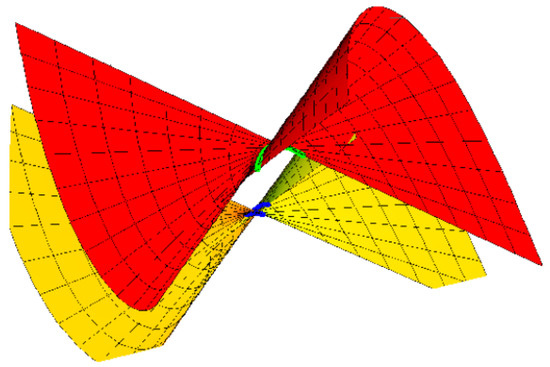
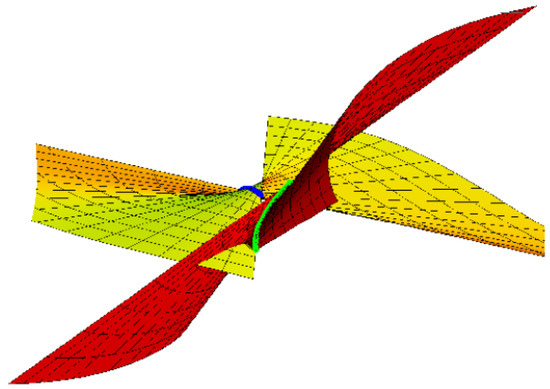
If and are points in the Euclidean 3-space , then the quadratic Bézier curve can be specified as
where
are the blending functions of the curve . It is easy to show that
After simple computation, we obtain
where . Selecting , , , and . Clearly, Equation (16) is satisfied, and the parametric surface specified by Equation (8) is
Let in Equation (7), and we obtain
Via Equation (5), we find
Then, we have
For , the oriented pair and the right pair, respectively, are shown in Figure 1 and Figure 2, where , and .

Figure 1.
Oriented pair {M, } with blue and green.

Figure 2.
Right pair {M, } with blue and green.
Example 2.
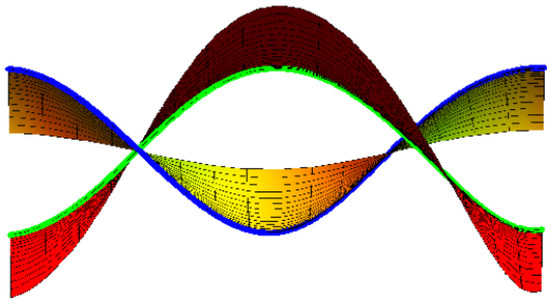
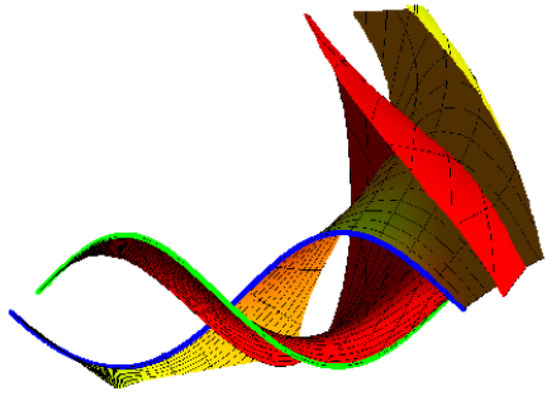
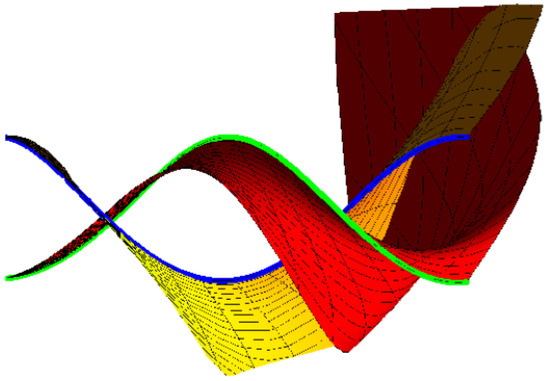
Given a helix
The Serret–Frenet frame is
Then, the parametric surface defined by Equation (8) is
Let in Equation (7), and we have
Via Equation (5), we find
Then, we have
(1) If we take , , where and , then Equation (18) is satisfied. The oriented pair and the right pair are identical; where approaches zero, , and (Figure 3).

Figure 3.
Oriented right pair {M, } with blue and green.
(2) If we take , , and , then Equation (20) is satisfied. The oriented pair and the right pair, respectively, are shown in Figure 4 and Figure 5, where , and .

Figure 4.
Oriented pair {M, } with blue and green.

Figure 5.
Right pair {M, } with blue and green.
Ruled Surface Family Pair with Bertrand Pair as Mutual Asymptotic Curves
Ruled surfaces are simple and common surfaces in geometric designs. Suppose that is a ruled surface with the base and is also an isoparametric curve of ; then, there exists such that . It follows that the surface can be represented as
where defines the direction of the rulings. In view of Equation (9), we have
For and , we have
The above equations are simply the necessary and sufficient conditions for which is a ruled surface with a base .
Now, we examine whether is also asymptotic on by employing Theorem 1. It is apparent that, in this case, it follows that
Then, at any point on , the should be in the osculating plane. Moreover, the and must not be parallel. It follows that
Substituting Equation (24) into Equation (22), we obtain
Then, the ruled surface family with the mutual geodesic can be specified as
where , , and . However, the normal vector to along the curve | is
which shows that is an asymptotic curve on . Then, the following theorem can be stated.
Theorem 2.
The ruled surface family pair {M, } interpolate the Bertrand pair {, } as common asymptotic curves if and only if there exists a parameter , and the functions , , so that and M are, respectively, parameterized by Equation (26), and
It must be pointed out that in Equations (26) and (28), there exist two asymptotic curves crossing every point on the curves (. One is itself and the other is a line in the orientation as given in Equation (24). Every constituent of the isoparametric ruled surface family with the mutual asymptotic is established by two set functions , .
4. Conclusions
In this work, we constructed the surface pencil pair and ruled surface pencil pair interpolating a Bertrand pair as common asymptotic curves in Euclidean 3-space . Moreover, some curves were selected to organize the surface pencil pair and ruled surface pencil pair that have the Bertrand pair {, } as common asymptotic curves. Hopefully, these results will be advantageous for work in computer-aided manufacturing and to those exploring manufacturing. Our results, presented in this paper, can contribute to the field of CAGD and have practical applications in CAM. The authors plan to register the study in different spaces and examine the classification of singularities as reported in [20,21,22].
Author Contributions
Methodology, R.A.A.-B.; Software, F.M.; Formal analysis, F.M. and R.A.A.-B.; Data curation, F.M.; Writing—original draft, R.A.A.-B. All authors have read and agreed to the published version of the manuscript.
Funding
This research received no external funding.
Data Availability Statement
The manuscript has no associated data.
Acknowledgments
Princess Nourah bint Abdulrahman University Researchers Supporting Project number (PNURSP2023R27), Princess Nourah bint Abdulrahman University, Riyadh, Saudi Arabia. We thank the anonymous reviewers for their careful reading of our manuscript and their many insightful comments and suggestions.
Conflicts of Interest
The authors declare that they have no conflict of interest.
References
- Carmo, M.P.D. Differential Geometry of Curves and Surfaces; Prentice-Hall: Englewood Cliffs, NJ, USA, 1976. [Google Scholar]
- Spivak, M.A. Comprehensive Introduction to Differential Geometry, 2nd ed.; Publish or Perish: Houston, TX, USA, 1979. [Google Scholar]
- Wang, G.J.; Tang, K.; Tai, C.L. Parametric representation of a surface pencil with a common spatial geodesic. Comput.-Aided Des. 2004, 36, 447–459. [Google Scholar] [CrossRef]
- Zhao, H.Y.; Wang, G.J. A new method for designing a developable surface utilizing the surface pencil through a given curve. Prog. Nat. Sci. 2008, 18, 105–110. [Google Scholar] [CrossRef]
- Li, C.Y.; Wang, R.H.; Zhu, C.G. Design and G1 connection of developable surfaces through Bézier geodesics. Appl. Math. Comput. 2011, 218, 3199–3208. [Google Scholar] [CrossRef]
- Kasap, E.; Akyldz, F.T.; Orbay, K. A generalization of surfaces family with common spatial geodesic. Appl. Math. Comput. 2008, 201, 781–789. [Google Scholar] [CrossRef]
- Li, C.Y.; Wang, R.H.; Zhu, C.G. Parametric representation of a surface pencil with a common line of curvature. Comput.-Aided Des. 2011, 43, 1110–1117. [Google Scholar] [CrossRef]
- Li, C.Y.; Wang, R.H.; Zhu, C.G. An approach for designing a developable surface through a given line of curvature. Comput.-Aided Des. 2013, 45, 621–627. [Google Scholar] [CrossRef]
- Bayram, E.; Guler, F.; Kasap, E. Parametric representation of a surface pencil with a common asymptotic curve. Comput.-Aided Des. 2012, 44, 637–643. [Google Scholar] [CrossRef]
- Liu, Y.; Wang, G.J. Designing developable surface pencil through given curve as its common asymptotic curve. J. Zhejiang Univ. 2013, 47, 1246–1252. [Google Scholar]
- Atalay, G.S.; Kasap, E. Surfaces family with common Smarandache geodesic curve. J. Sci. Arts. 2017, 4, 651–664. [Google Scholar]
- Atalay, G.S.; Kasap, E. Surfaces family with common Smarandache geodesic curve according to Bishop frame in Euclidean space. Math. Sci. Appl. 2016, 4, 164–174. [Google Scholar] [CrossRef]
- Bayram, E. Surface family with a common involute asymptotic curve. Int. J. Geom. Methods Mod. Phys. 2016, 13, 447–459. [Google Scholar] [CrossRef]
- Atalay, G.S. Surfaces family with a common Mannheim asymptotic curve. J. Appl. Math. Comput. 2018, 2, 143–154. [Google Scholar]
- Atalay, G.S. Surfaces family with a common Mannheim geodesic curve. J. Appl. Math. Comput. 2018, 2, 155–165. [Google Scholar]
- Abdel-Baky, R.A.; Alluhaib, N. Surfaces family with a common geodesic curve in Euclidean 3-Space . Int. J. Math. Anal. 2019, 13, 433–447. [Google Scholar] [CrossRef]
- Papaioannou, S.G.; Kiritsis, D. An application of Bertrand curves and surface to CAD/CAM. Comput.-Aided Des. 1985, 17, 348–352. [Google Scholar] [CrossRef]
- Ravani, B.; Ku, T.S. Bertrand offsets of ruled and developable surfaces. Comput.-Aided Des. 1991, 23, 145–152. [Google Scholar] [CrossRef]
- Sprott, K.S.; Ravani, B. Cylindrical milling of ruled surfaces. Int. J. Adv. Manuf. Technol. 2008, 38, 649–656. [Google Scholar] [CrossRef]
- Almoneef, A.A.; Abdel-Baky, R.A. Singularity properties of spacelike circular surfaces. Symmetry 2023, 15, 842. [Google Scholar] [CrossRef]
- Li, Y.; Alkhaldi, A.H.; Ali, A.; Abdel-Baky, R.A.; Saad, M. Investigation of ruled surfaces and their singularities according to Blaschke frame in Euclidean 3-space. AIMS Math. 2023, 8, 13875–13888. [Google Scholar] [CrossRef]
- Nazra, S.; Abdel-Baky, R.A. Singularities of non-lightlike developable surfaces in Minkowski 3-space. Mediterr. J. Math. 2023, 20, 45. [Google Scholar] [CrossRef]
Disclaimer/Publisher’s Note: The statements, opinions and data contained in all publications are solely those of the individual author(s) and contributor(s) and not of MDPI and/or the editor(s). MDPI and/or the editor(s) disclaim responsibility for any injury to people or property resulting from any ideas, methods, instructions or products referred to in the content. |
© 2023 by the authors. Licensee MDPI, Basel, Switzerland. This article is an open access article distributed under the terms and conditions of the Creative Commons Attribution (CC BY) license (https://creativecommons.org/licenses/by/4.0/).

